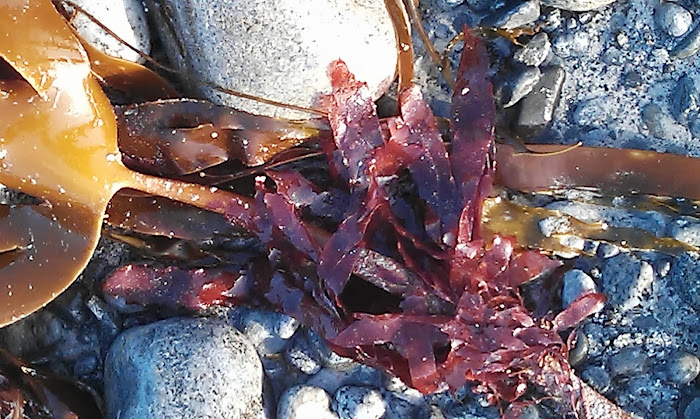British Seaweed is now
for sale on the High Street. Mara seaweed is available in Marks and
Spencer and fresh seaweed from The Cornish Seaweed Company is available in Tesco. Sea spaghetti or thong weed is as this company
says in their press release, the seaweed most reminiscent of a store cupboard
ingredient. Those who like to build seaweed bridges
might cook it 50:50 with wheat spaghetti. My foraged sea spaghetti cooks in
about 20-25 minutes. Blanched and
refreshed it's a useful salad ingredient. I mix dried and ground sea spaghetti
with Hebridean sea salt and I also use it in my seaweed sourdough starter. Once you
consider seaweed beyond green and slimy
and treat it as you would a vegetable, herb or spice, the culinary inventions
are endless. There is little didactic instruction available where seaweed is
concerned, so even the timid cook has little fear of criticism from the great
of the food world.
Kelp is now being farmed
in Ireland and sold ready to use. I note
that they blanche the kelps, oar weed
and sugar kelp, and also dabberlocks before it is frozen. This is useful information
for the forager with a freezer. If you forage your own sea spaghetti blanch this seaweed before freezing too. Well washed and dried dulse can just be popped in the freezer.
Dulse Palmaria
palmata growing on Kelp
Over the summer months
landlocked folk who holiday by the sea might check up on tide times and
chase a low spring tide (when the sea retreats to expose rocks usually covered
by water). Dulse is a delicious red seaweed to look out for. It grows on rocks
and also on other seaweeds It looks like a hand with fingers and varies in
colour from red to ruby brown.
False Dulse or Red Rags Dilsea carnosa
False dulse is available so check your specie carefully. Dulse remains
malleable when dried, which is why historically, coastal folk chewed it. I
think that it tastes of bacon. The red seaweeds are kitchen chameleons and release red pigment with heat. Culinary experimental is a colourful experience. Dulse cooks within potato cooking time and mixed
together a dulse and potato rissole is a cheap and tasty supper.
Seaweed in the Kitchen by
Fiona Bird is published by Prospect Books next month



